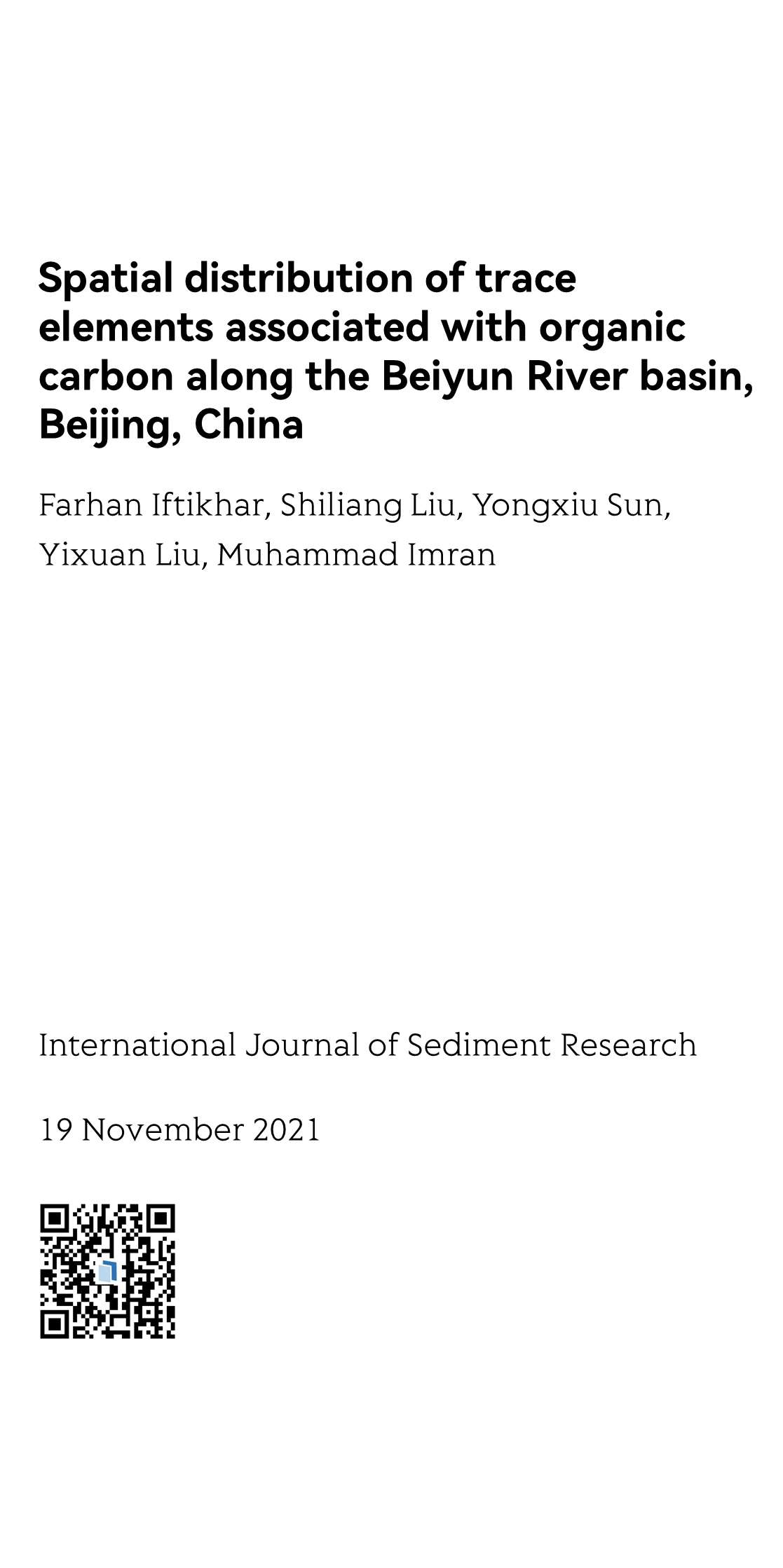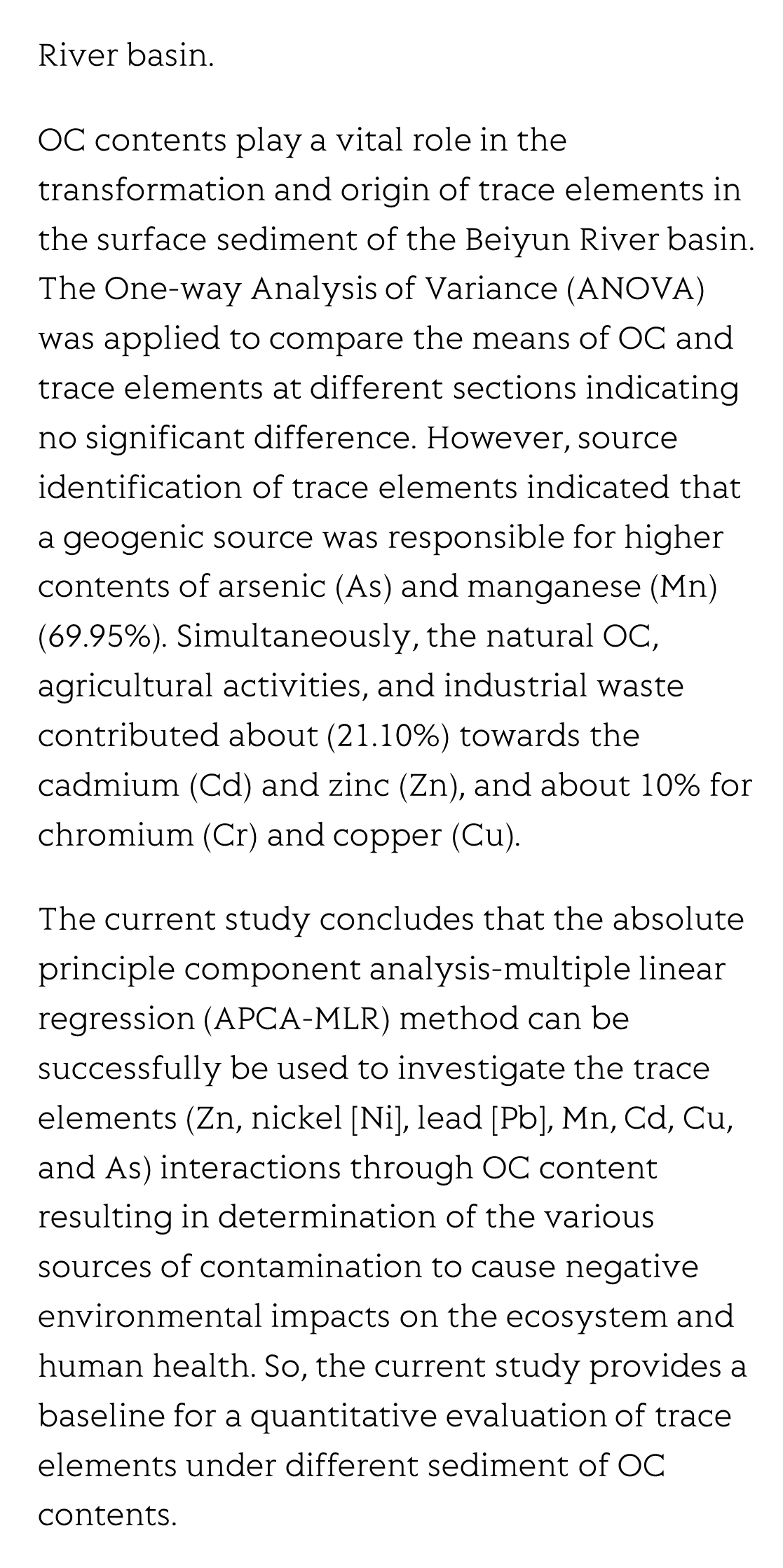(Peer-Reviewed) Spatial distribution of trace elements associated with organic carbon along the Beiyun River basin, Beijing, China
Farhan Iftikhar ¹, Shiliang Liu 刘世梁 ¹, Yongxiu Sun 孙永秀 ¹, Yixuan Liu 刘轶轩 ¹, Muhammad Imran ² ³
¹ School of Environment, State Key Laboratory of Water Environment Simulation, Beijing Normal University, Beijing 100875, China
中国 北京 北京师范大学环境学院 水环境模拟国家重点实验室
² Department of Soil and Environmental Science, Ghazi University, Dera Gazi Khan, Pakistan
³ Key Laboratory of Soil Resource & Biotech Application, Shaanxi Academy of Sciences, Xi'an Botanical Garden of Shaanxi Province, Institute of Botany of Shaanxi Province, Xi'an 710061, Shaanxi, China
中国 陕西 西安 陕西省科学院土壤资源与生物技术应用重点实验室 陕西省西安植物园陕西省植物研究所
Abstract
Pollution resulting from terrestrial and aquatic trace elements has become a severe problem across the world. Organic carbon (OC) content has a high affinity for metallic contaminants and it acts as a significant sink for trace elements. The decomposition of OC content directly influences the bioavailability of trace elements. The decomposition of OC content and OC distribution vary spatially, these processes affect the release of trace elements and need further research.
In the current study, sediment samples from the surface sediment along Beiyun River (Section 1 to Section 4 from upper to lower reaches), which is situated in the rapidly urbanized Beijing metropolis, were measured for OC, moisture, hardness, and trace elements. The OC contents were found to have a substantial difference among all four river sections along the urbanized river gradient. Whereas the higher OC contents were found in sections 2 (Urbanized uplands) and 3 (farmland) compared to those in sections 1(forest) and 4 (farmland and part of constructed areas). On the other hand, the highest value of the correlation coefficient was found among the different values of trace elements and OC content in the riverine zone of the Beiyun River basin.
OC contents play a vital role in the transformation and origin of trace elements in the surface sediment of the Beiyun River basin. The One-way Analysis of Variance (ANOVA) was applied to compare the means of OC and trace elements at different sections indicating no significant difference. However, source identification of trace elements indicated that a geogenic source was responsible for higher contents of arsenic (As) and manganese (Mn) (69.95%). Simultaneously, the natural OC, agricultural activities, and industrial waste contributed about (21.10%) towards the cadmium (Cd) and zinc (Zn), and about 10% for chromium (Cr) and copper (Cu).
The current study concludes that the absolute principle component analysis-multiple linear regression (APCA-MLR) method can be successfully be used to investigate the trace elements (Zn, nickel [Ni], lead [Pb], Mn, Cd, Cu, and As) interactions through OC content resulting in determination of the various sources of contamination to cause negative environmental impacts on the ecosystem and human health. So, the current study provides a baseline for a quantitative evaluation of trace elements under different sediment of OC contents.
Flicker minimization in power-saving displays enabled by measurement of difference in flexoelectric coefficients and displacement-current in positive dielectric anisotropy liquid crystals
Junho Jung, HaYoung Jung, GyuRi Choi, HanByeol Park, Sun-Mi Park, Ki-Sun Kwon, Heui-Seok Jin, Dong-Jin Lee, Hoon Jeong, JeongKi Park, Byeong Koo Kim, Seung Hee Lee, MinSu Kim
Opto-Electronic Advances
2025-09-25
Dual-frequency angular-multiplexed fringe projection profilometry with deep learning: breaking hardware limits for ultra-high-speed 3D imaging
Wenwu Chen, Yifan Liu, Shijie Feng, Wei Yin, Jiaming Qian, Yixuan Li, Hang Zhang, Maciej Trusiak, Malgorzata Kujawinska, Qian Chen, Chao Zuo
Opto-Electronic Advances
2025-09-25





